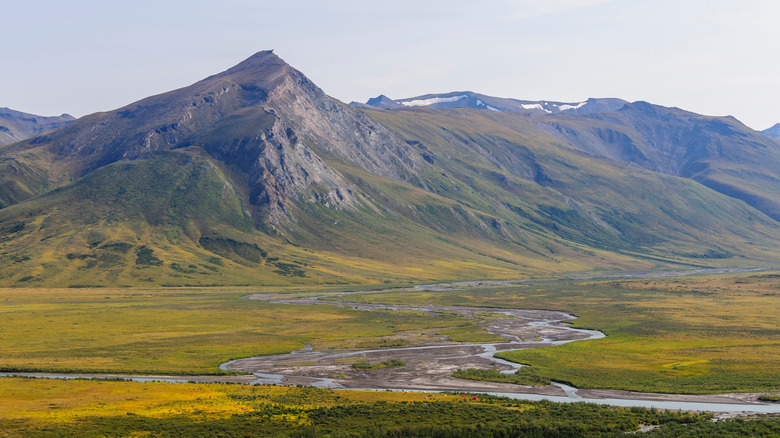The Least Visited National Park In The US Offers Amazing Nature Views
Backpackers, hikers, and nature lovers are some of the most common types of tourists to tread through national parks in the United States — even the least visited ones. You know the ones: destinations where there are no maintained roads, and any pathways are likely the creation of the region's native animals. One of these places is Gates of the Arctic National Park, which sits north of the Arctic Circle in Alaska, and boasts one of the last completely intact Arctic ecosystems on the planet.
The reason this 8.4-million-acre park is the least visited? It's extremely challenging to access. Don't expect to drive through impressive gates, or find an expansive visitor center here. In fact, don't expect to bring any type of vehicle. Those hoping to take in the natural beauty of Alaska north of the Arctic Circle usually arrive by small plane from the nearby towns of Anaktuvuk Pass and Bettles.
However, the effort it takes to reach Gates of the Arctic is worth it solely for the up-close look at the north's natural beauty. That said, it's important to book a guide for your adventure into the wilderness. Bettles, especially, is known for its experienced guides, accommodations, and tour packages that help ensure a safe experience. Like the park, Bettles is only accessible by air taxi from Fairbanks, which just so happens to be one of the best places on Earth to see the Northern Lights in the fall.
Exploring Gates of the Arctic National Park by air, foot, and water
Flights into both Bettles and Gates of the Arctic National Park offer incredible views of the untouched land. And while some tourists may take to the trails, others may prefer to view the tundra from the water. Thankfully, there are six designated Wild Rivers in the park, which are draws for kayakers and rafters, and each river has areas where it's easy to load in or take out your watercraft. For a more exciting experience along the riverways, there are also a range of rapids ranging all the way up to Class IV. Once on the water, visitors will likely see caribou, moose, sheep, and grizzly bears — just some of the wildlife that call Gates of the Arctic home.
Meanwhile, those exploring on foot must keep in mind that the terrain here is rough. Not only are there no official, manmade trails to follow — only "game trails" created by animals. Even then, experienced hikers typically only clock around five miles of walking each day. Luckily, for those not looking to hike for miles on end, fishing in the region's lakes is a popular pastime, and guided fishing expeditions are recommended. Keep in mind that a license is required, and you can grab one in Fairbanks or Bettles before entering the park. Accommodation-wise, camping is allowed in the park, but there are no designated campgrounds. This means that proper planning is necessary to ensure a safe visit for both the human explorers and the arctic ecosystem.
More tips for visiting Gates of the Arctic National Park
Gates of the Arctic National Park is untouched and natural, which means that it's not an easy escape for casual day-hikers or adventurers. Planning is certainly a necessity for a visit to this remote part of the world. If you're unsure whether or not you can handle it, you might want to reconsider your visit altogether to avoid putting yourself in a dangerous situation. Instead, if you're dreaming of exploring Alaska's beauty, but prefer easier access, you might want to consider exploring Katmai National Park, an underrated beauty known for brown bear sightings.
The most popular time to visit this part of the world is in June. That's when the ice finally lets go of the rivers, giving adventurers access to the many waterways. Temperatures are also much more pleasant in the summer, with highs in the 70-degree Fahrenheit range, and it's also a lot drier. Finally, daylight is also plentiful, as there is no sunset here between May and early August.
From early December to early January, Gates of the Arctic National Park sits in darkness. The sun does not rise during this time of the year, although twilight does offer some relief. Winter is also very cold, with temperatures dropping below minus 50 degrees Fahrenheit. If you want to experience a true arctic winter without the extreme isolation, you may want to consider visiting America's northernmost town of Utqiaġvik, a remote destination that's brimming with its own breathtaking views along the Arctic Ocean.


